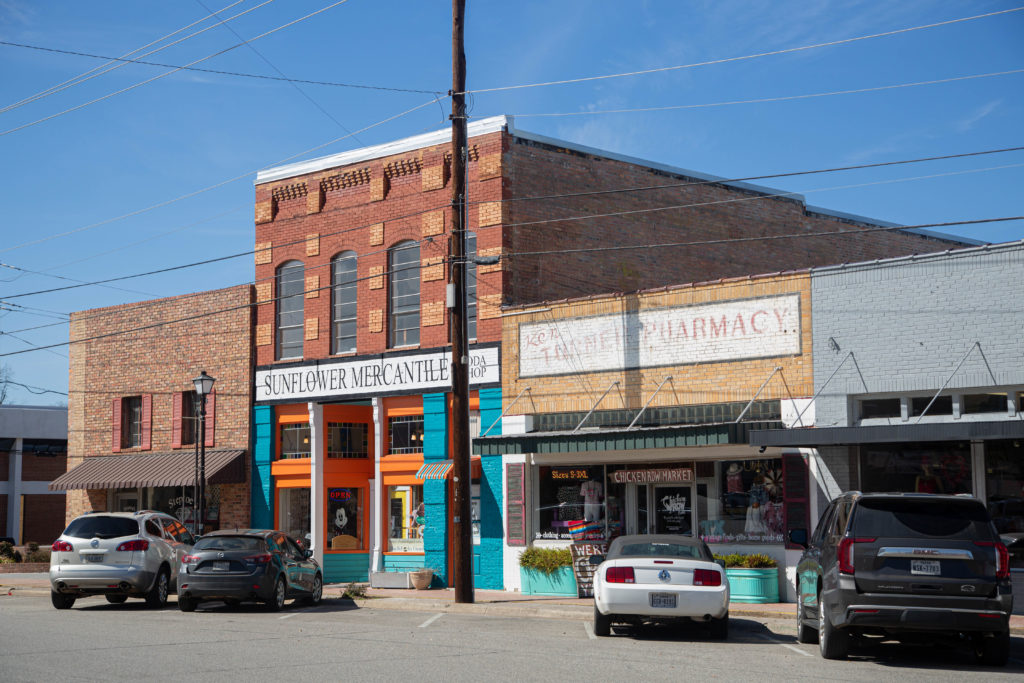Back to Carthage: East Texas town looks to pandemic homecomers to stem population loss


by Jill Ament
In East Texas’ piney woods, not far from the Louisiana border, lies the town of Carthage. It’s small, just 6,500 people, with a tearoom, a thrift store, a cafe and a barber shop in its town square.
But there is also a handful of vacant buildings.
The town drew native Jennifer Edwards back after living for years near Fort Worth. The 39-year-old and her husband, Anthony, moved back to Carthage about three years ago. Edwards has deep roots there.
“My family’s been here since 1830, on the same plot of land. We still have that land. We do farming, small-scale farming,” Edwards said.
Edwards, who is Black, inherited the land that was passed down from her great-great-great grandfather who was deeded the land by the state nearly 200 years ago when he became a freedman. Keeping the land in the family is important to the Edwards; they want to pass it on to their daughter.
But reestablishing roots in a part of the state that isn’t exactly thriving could be a challenge. Carthage is the seat of Panola County, which has lost about 1,300 people since 2010. Carthage itself has lost about 200 people since then. Other rural parts of Texas have been losing population, too. Census data show that populations declined in 143 of Texas’ 254 counties between 2010 and 2020. That’s more than half of all counties.
Texas State Demographer Lloyd Potter says it has much to do with employment opportunities drying up. And with fewer job opportunities, young people tend to leave small, rural towns after they graduate high school.
“If they want to go to post-secondary education or they want to work in a job that’s, you know, potentially higher paying, they’re going to have to move to a more urbanized area,” Potter said.
Unlike Jennifer Edwards, Potter says most young adults don’t return, which means some smaller communities are aging and dying out. But Edwards wants to buck that trend, and she’s not alone. Edwards’ own move back to Carthage was part of that effort; so is her job as executive director of Tarleton State University’s Rural Communication Institute in Stephenville. She helps provide higher-education opportunities for people living in small towns in the area.
“Growing up in a rural area, I realized that I was at a disadvantage,” Edwards said. “I realized that a lot of opportunities were had by people who lived in larger cities and towns. So, because of that, I wanted to bridge that gap for other people who are growing up in our small towns.”
Edwards is also looking for other ways to keep people living and working in Carthage. She and her husband are working with the chamber of commerce to bring in new businesses, beyond the Tyson poultry plant and oil-and-gas companies that are the primary employers. There’s also a push to bring in faster broadband internet so people can work remotely. That means people could still live a more rural lifestyle, but work jobs that might not be available in the immediate area.
Edwards also wants to attract more mom and pop shops. John Ray, chairman of Panola County Chamber of Commerce, says more small businesses are starting to open up because it’s affordable to live there.
“People are giving a second look to their hometowns, I think. Especially through COVID, we saw a lot of people return home. And so, you know, they’re taking notice that there’s things here, great benefits to being in a small community,” Perot Vance said.
New census data show that Perot Vance might be right. So far, data collected during the pandemic indicate that some counties with population loss prior to the pandemic have started to see growth. But Potter, the state demographer, warns, it’s not a complete reversal – at least not yet.
“I won’t say a complete turnaround, but you know, some of the biggest counties that had been losing population are now, people are moving there,” Potter said.
Panola County included: it regained 200 people just during the pandemic.
For the Edwardses, helping Carthage thrive is a way to honor their family legacy that goes well beyond Jennifer’s great-great-great grandfather’s plot of land. Her cousin, Mildred Faye Jefferson, who grew up near Carthage, was the first black woman to graduate from Harvard Medical School. Jefferson is memorialized in a statue in Carthage’s town square. The Edwardses want their daughter to grow up close to reminders of that legacy.
“It’s important for us that she gets to be a part of this history, and, you know, what it means to be a part of that and what it means to carry that forward,” Jennifer said.
For them, Carthage is home now … again.
This story was done in collaboration with Reporting Texas, an online publication out of the University of Texas at Austin’s Graduate School of Journalism and Media.
If you found the reporting above valuable, please consider making a donation to support it here. Your gift helps pay for everything you find on texasstandard.org and KUT.org. Thanks for donating today.